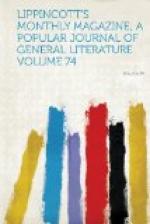Sir Robert had the boudoir, to which he devoted exactly two hours after breakfast. He had a geological chart of America, with what he felt to be melancholy blanks for the chalk and oolite beds of his own country, and appropriate fossils indicated by an index-finger in red ink. He had the Poor-Law and electoral systems to master, as well as the prison systems of the different States. He had to prove that the Mound-Builders and the race that built the buried cities of Central America were one and the same. He had innumerable questions, political, social, agricultural, pressing upon him, from the history of spiritualism, the purity of the ballot, and the McCormack reaper, down to certain expressions that immensely struck and pleased him, which had to be entered in the diary as “unconscious poetry of the Westerners,”—such phrases as “the fall” (of the leaf), “morning-glories,” “dancing like a breeze,” “Daphnes” (instead of laurels), and many more, which he hoped would be “permanently engrafted on the mother-tongue.” There were other entries to be made,—“customs of the Westerners,” their “descent,” “taxation,” “climate” (as affected by the Great Lakes), “population in 1900,” and so on. There were books, books, books, to be read, referred to, ordered. There was even a little taxidermy to be done, and the “native birds” to be first sought, then bought, then prepared, and packed to be sent back to England. The others, if not quite so busy, were anything but idle. Miss Noel walked her five miles a day. She was out sketching for hours under her umbrella, no matter what the weather was, and only said, “Thank you for your kind concern, but I am quite equal to it,” when Mrs. Ketchum, astonished to see a woman of her own age enduring such fatigue and running such risks, undertook to remonstrate with her. “One must get one’s constitutional, you know, and one must not mind a drop or two. There has been no really bad weather yet, —nothing to keep one in-doors, at least.” If she stayed in-doors, she and Mrs. Sykes (when the latter was not scouring the country on foot or horse-back) interested themselves in their plants, minerals, seeds, drawings, the herbarium, the Wardian case, the diaries and letters and fancy-work, the beautiful collection of sea-weed sent by Miss Marlow from New England, and a dozen things besides. Mr. Heathcote, meanwhile, was walking, and riding, and visiting, and, above all, photographing. He got a small covered cart, into which he would put his photographic apparatus and go the rounds of the country-side alone, getting his luncheon as he could, and coming back late in the evening, flushed with heat and victory, bringing amusing accounts of his experiences, a bouquet as of an apothecary-shop, and “proofs” of “a lane,—quite an English-looking lane,” “a dog on the chain,” “rear view of an American public” (house), “Saint Lieuk’s Church” (five different aspects), “what the natives call an ’ash-hopper,’—came out beautifully,”




